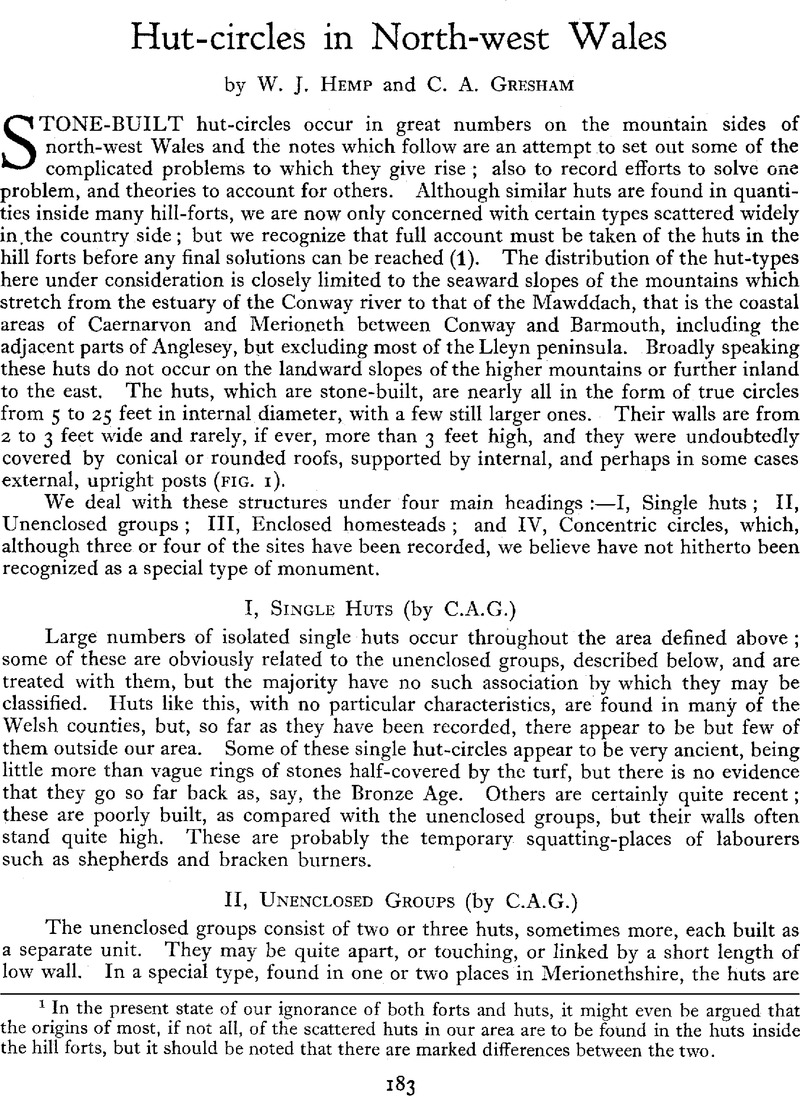Article contents
Hut-circles in North-west Wales
Published online by Cambridge University Press: 02 January 2015
Abstract

- Type
- Research Article
- Information
- Copyright
- Copyright © Antiquity Publications Ltd 1944
References
1 In the present state of our ignorance of both forts and huts, it might even be argued that the origins of most, if not all, of the scattered huts in our area are to be found in the huts inside the hill forts, but it should be noted that there are marked differences between the two.
2 And also, probably, the surface geology, e.g. the areas adjoining the Caernarvonshire banks of the Menai Straits, which are partly covered by drift gravels show no signs of early cultivation.
3 Royal Commission on Ancient Monuments in Wales : Anglesey, p. LIX.
4 Curwen in ANTIQUITY 1927, 1, 282, and Proc. Prehistoric Soc, IV, 37; Trans. Devon Assoc. XXVIII, XXIX, XXXIV, etc.
5 Cf. The distribution of Megaliths along the western sea routes.
6 Guide to the Collection Illustrating the Prehistory of Wales, pp. 106–111.
7 Personality of Britain, 1938, p. 70 fn.
8 Yorkshire Arch. Journ., 1939, XXXIV, 115–50.
9 The total area of ground so cultivated by the occupants of a single homestead might amount to 2 or 3 acres or more. The terraces themselves often exceed 5 feet in height.
10 See Arch. Camb. 1923, plan opposite p. 293 and Ant.Journ. 1936, p. 296, pl. 50.
11 Patches of strip lynchets do occur, e.g. in Flintshire above Holywell, but there the type is different, and the long strips are sometimes set sideways to the slope. Probably they are due to the Saxon occupation of the district. It may be significant that the place-name Gerddi Belino (Beuno’s Gardens) occurs among them. The Saint of that name was closely connected with Holywell.
12 Arch. Camb. 1922, 335–45; 1923. 87–113 and 291–302.
13 Ant.Journ. 1936, 295–320.
14 As recorded by Camden in 1607, J. E. Lloyd, A History of Wales, p. 111, n. 67.
15 H. O’Neil Hencken. The Archaeology of Cornwall and Scilly, p. 132, et seq.
16 V. Gordon Chil’de. The Prehistory of Scotland, p. 189, et. seq.
17 R. G. Collingwood. Roman Britain and the English Settlements (1941 éd.), p. 289.
18 For a convenient summary by C. A. Gresham see ANTIQUITY 1942, XV, 237–57.
19 Roman Britain, pp. 142 et seq.
20 ANTIQUITY 1943, XVII, 136.
21 Proc. Soc. Ant. Scotland, 1938–9, pp. 289–315.
22 Dr Christison (Early Fortification in Scotland, p. 355), gave some description of some of these Bowmont homesteads and other sites which he comprehensively terms ‘forts’. See also his plans of ‘unfortified enclosures’, p. 370, and reference to Bowmont terraces, p. 373.
23 Dwellings in the parish of Manor, Peebleshire, in several ways comparable with the ‘homesteads’, were apparently occupied in medieval times. Proc. Soc. Ant. Scot., LXXV, 92. Were they lineal descendants of the neighbouring early sites ?
24 Arch. Camb., 1866, p. 216. This plan is labelled Llanllechid, but the description on p. 266 correctly describes it as at the foot of Moel Rhiwen in the parish of Llanddeiniolen. See FIG. 4 of this present paper, the result of a recent survey.
25 See plan of Chysauster, p. 134.
26 Arch, Camb. 1922, p. 339. N.B. the crescent-shaped enclosure adjoining the circles to the north is a normal cultivation terrace.
27 A somewhat muddled description of this site is given in R.C.A.M. Wales, Merionethshire, no. 212 (1).
28 R.C.A.M. Wales. Merionethshire, no. 160. The plans by Mr H. H. Lynes there published are fanciful and his observations may be ignored,
29 Arch. Camb. 1920, pp. 114–16. The excavation produced an iron ring, possibly a terret ring.
30 Arch: Camb. 1919, p. 534.
31 The Heart of Northern Wales, vol. 1, p. 113.
- 2
- Cited by




